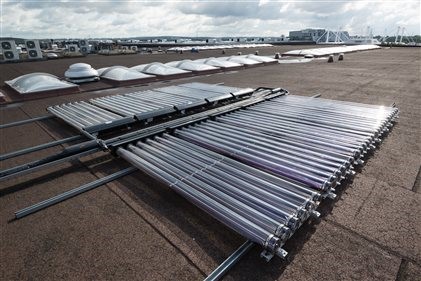

|
Edward Lowton
Editor |


|
| Home> | Premises management/maintenance | >HVAC | >Stokvis Solar at Birmingham International |
| Home> | Energy Management | >Sustainable energy | >Stokvis Solar at Birmingham International |
Stokvis Solar at Birmingham International
05 June 2017
Installation of a 10 panel solar array featuring Stokvis Energy Systems solar collectors, to serve facilities at Birmingham International Rail Station, is being assessed as a potential pilot for a wider roll out of renewable energy across the facilities operated by Network Rail and Virgin Trains nationally.

The project was jointly commissioned by Network Rail and Virgin Trains, with renewables specialist ECO2SOLAR carrying out the installation of the Stokvis solar equipment.
In addition to the 10 Stokvis DF100-6 Evacuated Tube Collectors - offering a net absorber area 10.69m - the manufacturer supplied a Stokvis Solar Bloc Maxi pump-station, and a Stokvis Resol BX Plus differential temperature controller, providing up to eight sensor inputs.
Richard Davis, the engineer in charge of the project for Virgin Trains, commented: "We chose to use Stokvis equipment because I was already aware of the company's reputation for offering high quality products to the health sector and hotel chains; and have previously attended a seminar on their systems and products. This was always going to be a challenging retrofit, and although there have been some initial teething issues, Stokvis UK sales director, Keith Howard has been really proactive in resolving them. I believe we are going to see real savings."
The solar fluid contained within the solar collectors is circulated by the solar bloc pump station to a large surface area coil contained within a 1000L stainless steel thermal storage vessel which provides a ‘pre-heat' for the domestic hot water, serving the station's toilets and various shops and eateries around the main concourse linking to the airport and NEC.
This solar preheat system raises the temperature of the incoming mains water from a typical 10° to around 35°C, although it is expected to reach 55 to 60°C in high summer.
The pre-heated cold water feed water then serves two existing gas fired water heaters which then increase the DHWS to 60°C. This arrangement results in the gas fired water heaters not firing as regularly or having to raise the cold water supply from 10 to 60°C as was previously the case.
The installation also features a heat meter to measure the output from the panels in kilowatt hours to enable the client to assess not just the benefit of the system, but also the level of payment possible under the Renewable Heat Incentive (RHI).
- Heat interface units
- Plate heat exchangers: New guide
- 3D models & Product Data Sheets
- Combination hot water solution on a plate
- Boiler update completed on time
- Boilers combine economy with compact design
- Systems on show
- Interface units will be on show
- Efficiency and flexibility
- Plate heat exchangers

















